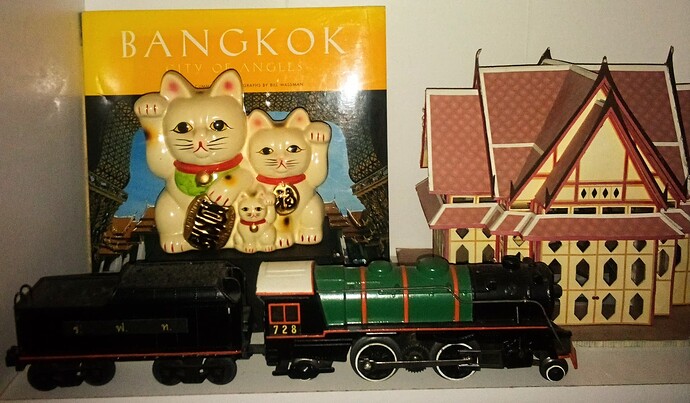Eric, not to ask you to give away all your techniques, but I’m curious:
it appears you are shooting outdoors in natural sunlight, because of the shadows, correct? I’m wondering about the backgrounds; are they photos placed behind the trains ?
Paul
My goal in taking these photos is to showcase Marx locomotives and rolling stock and make everything look as realistic as possible.
All of my photos are photographed outdoors under natural sunlight on a “diorama stage” (i.e. a sheet of plywood measuring 38” x 48”).
Most of the backgrounds are 24” x 36” photo enlargements mounted onto foamboard. (I also have some backgrounds which are enlargements of vintage post cards.) Most of the photos used for the backgrounds were taken by me.
To help maintain the illusion that my O-gauge trains are their full-size counterparts, I use the ballast sold by Brennan’s Model Railroading, using a paintbrush to form the roadbed and work the ballast in between the ties. (After each photo session, the ballast is swept up and saved for the next session.)
To complete the scene, a few extra props are added.
None of these setups are permanent and are preserved only in the photos.
The 30th Anniversary special issue of Classic Toy Trains magazine, which came out in 2017 ran an article on my photo work which explains everything in more detail.
For me, it’s hard to pick a favorite Marx loco, and @Eric1946 it’s hard to pick a favorite among these photos, but wow that customization really makes that Crooks pop! That might be my favorite tender, it’s just plain fun.
Fantastic job! BETTER than new!
I posted a picture of my repaint of my Marx “William Crooks” a while back but don’t remember under which topic. I can do it again if you like.
That’s what this thread is for!
Thank You, your photos are excellent!
I dabble a little with photography as a secondary hobby, which started with railfanning. Very impressed with your pictures.
Paul
Union Pacific M-10000 articulated streamliner
(Introduced in 1934 in time for Christmas, the M-10000 was Marx’s first articulated streamliner.)
Those M-10000 sets sold in 1934 also included an aluminum “lucky piece” that was most likely left over from the prototype M-10000’s appearance at Chicago’s Century of Progress.
Expensive to manufacture, the M-10000 was replaced by the Union Pacific M-10005 “City of Denver” articulated streamliner in 1937.
The cream/green/orange is my favorite of the M10005s!
A cream/green/orange M10005 articulated streamliner was my first electric train set, received for Christmas when I was not quite 5 years old.
The one I have has a freight coupler ![]()
Here’s a pic of my #24965 Walgreen’s Amy set. I is parked somewhat incongruously in front of the Nativity. It was in LN condition with most of the men and accessories (although the US flag was missing, and someone in the past had tossed a Confederate flag in its place ![]() ).
).
I was somehow convinced to let this one get away from me–probably by an excess of trains and a lack of room. sigh
I received a cream & green M-10005 City of Denver electric train set like this one for Christmas in 1950 when I was not quite 5 years old. (That set might have been made earlier than 1950 and been passed along to my folks to give to me.)
The M10005 City of Denver enjoyed a long production run. Introduced at Christmas time in 1936, a mechanical version was still being made as late as 1949.
Marx later released freight sets headed up by two M-10005 diesels coupled together in an A-A configuration.
About 1938, Marx used the tooling for the M-10005 City of Denver’s coaches to create the coaches for a new articulated passenger train based on the New York Central’s popular Cleveland-Detroit passenger train Mercury.
In 1938, Marx introduced its version of the New York Central Mercury, the first luxury streamliner to be designed as a unit, both inside and out.
The coaches for this set were made using the same tooling used for making Marx’s 10005 City of Denver articulated streamliner coaches. The problem of coupling them to the new Mercury locomotive was solved by using a special articulated tender that served as a transition car.
Mercury sets were available in three basic color combinations: gray & cream, red & white, and copper & black. (As is typical with many of the gray & cream Mercury passenger coaches encountered today, the ones in my set appear to be olive & cream. This is believed to have been caused by a careless mixing of the gray.)
For the copper & black sets, the copper finish was achieved by applying a yellow/orange vanish to bright tin plate.
Wow, that is very nice. Beautiful workmanship!
Rich









